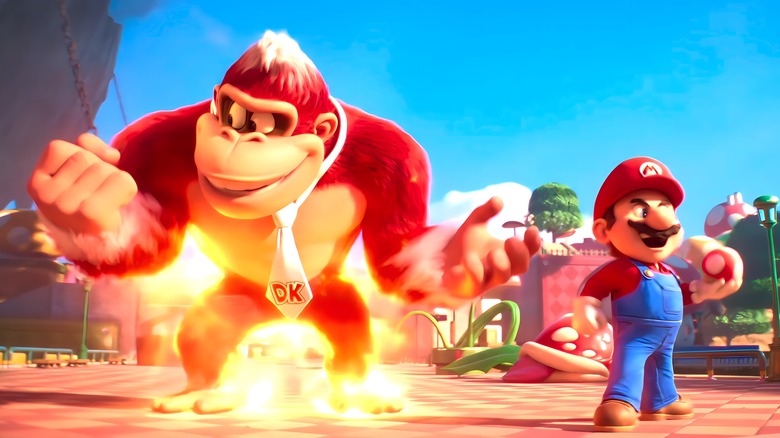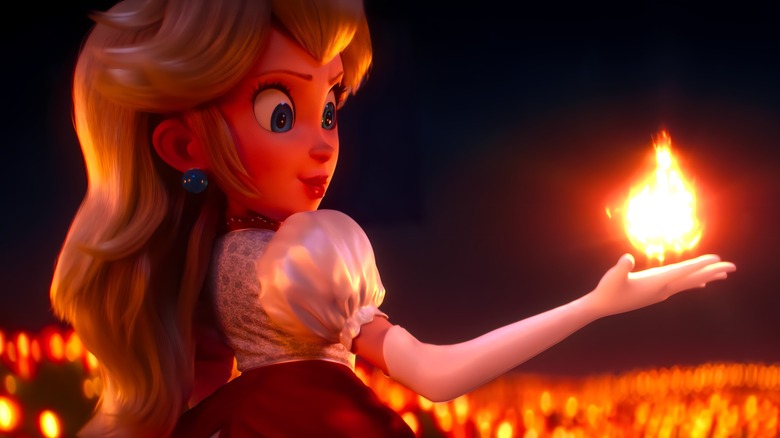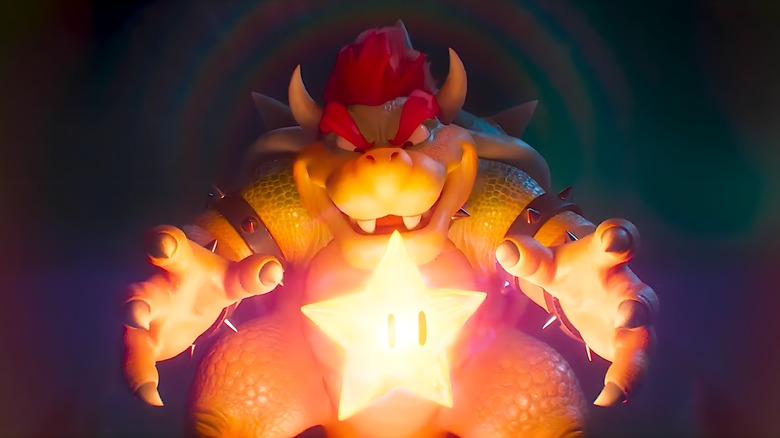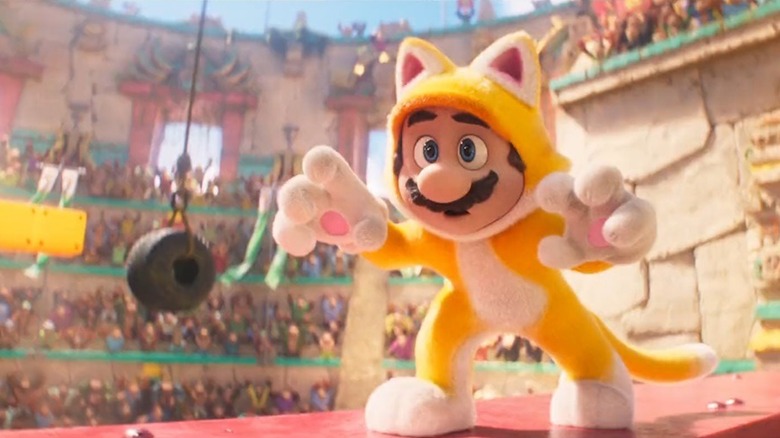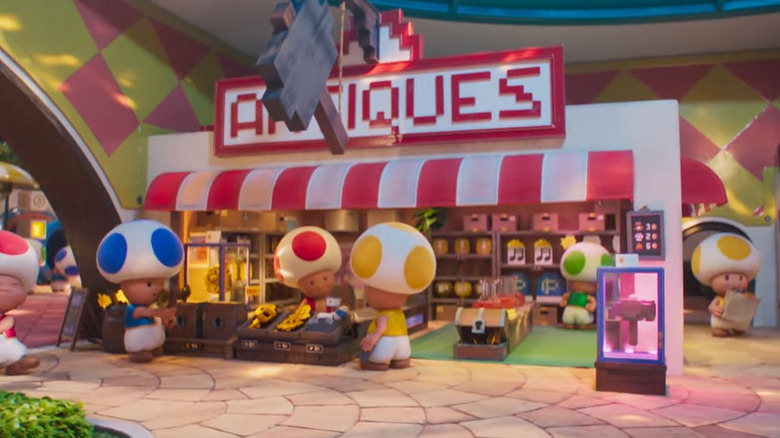Every Classic And Not-So-Classic Power-Up In The Super Mario Bros. Movie
Video game power-ups are a familiar enough concept to a mass media-consuming public that Aaron Horvath's and Michael Jelenic's new film "The Super Mario Bros. Movie" doesn't bother to explain it for a second. If you consume a power-up, you're granted temporary superpowers. In terms of real-world physics, power-ups make about as much sense as, say, trapping a monster inside of a spit bubble, slamming them against the wall, and watching them magically transform into fruit (the premise of Taito's 1986 video game "Bubble Bobble"). But video games have been dictating their own surreal inner logic for decades, and audiences will readily accept any scenario.
In "The Super Mario Bros. Movie," the only primer that audiences are given regarding power-ups is when Princess Peach (Anya Taylor-Joy) explains to Mario (Chris Pratt) that floating metal boxes, festooned with question marks, contain power-ups that can be freed by punching them. One can eat or touch the power-up inside and gain its powers. When you get hit, the power-up loses its effect. The whole video game logic makes perfect sense, but in a movie, power-ups are a bit of an odd concept.
However, for the world's millions of Mario fans, seeing particular power-ups on the big screen within the context of a story will likely elicit a rush of nostalgia. Many of the items from the games were written into Horvath's and Lelenic's new film, with some coming from the original "Super Mario Bros." from 1985, and others coming from more recent platforms. Here is a comprehensive list.
Mushrooms
Super Mushrooms. One of the gags of "The Super Mario Bros. Movie" is that Mario hates mushrooms back on Earth. In the fantasy world of the Mushroom Kingdom, where the bulk of the film's action takes place, raw mushrooms are a handy way to become stronger. When Mario eats one, he grows by one foot and gains the ability to jump to new heights. Red mushrooms are the most common power-up throughout the Mario games, causing the character to grow larger and jump higher. In "Super Mario Bros. 2" (1988), the mushrooms also added one point to a player's life meter. In the "Mario Kart" racing games, mushrooms give a temporary speed boost. In the "Mario Party" games, they add points to a die roll. In the "Paper Mario" games, they restore hit points. Mushrooms are, in Mario lore, a handy cure-all.
Mini Mushrooms. "The Super Mario Bros. Movie" also contains blue-capped mushrooms that, when eaten, shrink the consumer down to a miniature size. The mushrooms are kind of like the "eat me" and "drink me" treats from Lewis Carroll's "Alice's Adventures in Wonderland." The mini-mushrooms first appeared in the 2004 game "Mario Pinball Land," where they shrunk Mario down to a size that allowed him to maneuver smaller passageways. In "New Super Mario Bros." (2006), the mini-mushrooms allowed the player to jump higher, float through the air, and run across the surface of water. In the movie, they're seen as having no advantages.
Fire Flowers: On a few occasions, characters in "The Super Mario Bros. Movie" brush their fingers across some local flora, infusing them with fire-throwing powers. Peach and Donkey Kong (Seth Rogen) both employ fire as a camping aid and as a combat weapon. This item, like the mushroom, has appeared in almost every Mario game since 1985.
It's always stars
Ice Flowers: At the film's climax, Peach is in a tight spot and manages to gain access to a blue flower that — like the fire flower — imbues her with elemental powers. Her dress turns blue, and she can fling ice balls. These can freeze attackers in blocks of ice or halt machinery. The ice flowers first appeared in a 1990 issue of "Super Mario-kun," a manga series that has been released periodically in Japan up until this year. In the games, the ice flowers first appeared in "Mario & Luigi: Partners in Time" (2005). Across dozens of games, the ice flowers essentially turn the player into Elsa from "Frozen."
Stars: The central McGuffin from "The Super Mario Bros. Movie" is a glowing star, a power-up so powerful, it could allow the evil Bowser (Jack Black) to conquer the Mushroom Kingdom. Another artifact from 1985, the star temporarily imbues the player with invincibility, letting them run headlong through attackers. It, too, appears in multiple forms throughout Mario games. In the "Party" games they're acquired as currency, and collected as rare trinkets in "Super Mario Galaxy." In the movie, Bowser doesn't want to use it right away, allowing Mario and Luigi to grab it at the film's climax.
The Tanooki Suit: Inspired by the Japanese myth of the tanuki, a species of raccoon/dog, the Tanooki Suit first appeared in "Super Mario Bros. 3" (1990). It was a set of cuddly pajamas that allowed the player to temporarily fly, and also become a statue for a few seconds (letting enemies wander past). Mario wears a Tanooki Suit in "Movie," but can spin his tail like a helicopter, allowing him to fly. It's less common than the power-ups listed above.
Meowser
The Cat Suit: Like the Tanooki Suit, Mario also could dress up like a cat, allowing him to climb trees, pounce on prey, scratch enemies, and poop in a box. That last part is a mere headcanon. The catsuit first appeared in "Super Mario 3-D World" (2013) and has popped up in only a few other games since. In the movie, Mario unwittingly dons a catsuit to battle Donkey Kong. In an amusing colloquialism, when Boweser gains cat powers in the 2013 game, he is called Meowser.
The Mario Kart items: Seeing as "Super Mario Kart" (1992) and its many sequels are racing games, the power-ups have been altered to change their usefulness in a driving scenario. In "Movie," when the characters have to go-kart across a massive rainbow bridge, they drop multiple banana peels at pursuers, employing one of the game's most common items. When a turtle loses its shell, Mario salvages it and slides it across the track, causing an enemy to crash. Green shells are also common in "Mario Kart." When an angry Koopa finds he can't beat Mario at racing, he announces his killing move: shrinking into his own blue shell, and flying through the air to explode the kart of racers ahead of him. In the "Kart" games, the blue shell seeks out whatever racer is in first place and stymies them with an explosion. Many "Mario Kart" players can speak of their hatred for such an item.
The Antique Shop
The Antique Shop: In "Movie," as Mario wanders through the Mushroom Kingdom, he passes an antique shop, and the filmmakers filled it with a few cute Easter eggs. For sale is a hammer, as well as a music box, items that one can use in "Super Mario Bros. 3." The hammer can be used on the game's map screens, allowing the player to access new paths and secret areas. The music box is used to put certain attackers to sleep. There is a gold Dragon coin, found in "Super Mario World" (1990), and some bells which create the catsuit. There are blue P-Switch blocks, which, in in-game lore, transform blocks into coins and vice versa. There is also a rack of yellow balloons, emblazoned with a "P," which first appeared in "World," and puff the player up into a flying balloon version of themselves.
The shop also sells keys, a pretty common item across all video game lore, as well as the treasure chests from "Mario 3." It sells no soap, though. That's the real world.
In a cute reference, the shop owner tells a customer that the item he is holding will still work, so long as you blow into it. This was an old trick that NES players used on their old cartridges. If a game cartridge didn't work, it was considered a fix-all to remove it from the NES, blow onto the circuitry, and re-insert it. It seems that NES games exist, even in Mario's own fantasy world.
